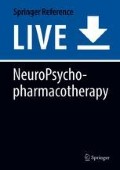Abstract
When Japanese psychiatry was in its infancy, the disease concepts held by individual physicians varied, and even the same diagnosis could sometimes refer to a completely different group of symptoms. Based on such reliability problems of psychiatric diagnostics, DSM-III (Diagnostic and Statistical Manual of Mental Disorders – Third Edition) was introduced to Japan in 1982. Since then, the reliability of psychiatric diagnostics has increased. Fields such as clinical practice, education, and research in Japan have also benefited from DSM. However, it is also true that the misuse of DSM by inexperienced users has caused adverse effects. The misuse of DSM is attributed mainly to the misunderstanding that “it’s a disease simply because it’s specified in DSM diagnostic criteria.” DSM diagnostic criteria have been created to stipulate the core of each disease. Thus, in using those criteria, sufficient understanding of the ideal type of the disease, the characteristics and symptoms including those not stated in DSM, is a prerequisite. Attempting to extract a homogeneous population based on such an appropriate use has been a challenge of DSM to date. Reaffirming this basic idea of DSM is necessary for the future development of psychiatric diagnostics. In addition, we must not forget that psychiatric diagnostics strive not only to provide diagnosis of a disease but also to understand human beings from a multifaceted viewpoint, bearing in mind each patient’s personality as well as the social and environmental background.
References
American Psychiatric Association. Quick reference to the diagnostic criteria from DSM-III. Washington, DC: American Psychiatric Association; 1980. (Translated into Japanese by Takahashi S, Hanada K and Fujinawa A. Tokyo: Igaku Shoin; 1982.)
Cooper JE. Psychiatric diagnosis in New York and London. Maudsley monograph no. 20. London: Oxford University Press; 1972.
Feighner JP, Robins E, Guze SB, et al. Diagnostic criteria for use in psychiatric research. Arch Gen Psychiatry. 1972;26:57–63.
Friedman RA. Grief, depression, and the DSM-5. N Engl J Med. 2012;366:1855–7.
Kasahara Y, Kimura B. Utsu jōtai no rinshōteki bunrui ni kansuru kenkyū (Study on clinical classification of depressive state). Seishin Shinkeigaku Zasshi. 1975;77:715–73.
Kendler KS. Phenomenology of schizophrenia and the representativeness of modern diagnostic criteria. JAMA Psychiat. 2016;73:1082–92.
Kitamura H. DSM recommendation to refine psychiatric diagnosis. Arch Psychiatr Diagn Clin Eval. 2016;9:46–52.
Kitamura T, Shima S, Sakio E, et al. Psychiatric diagnosis in Japan. I. A study on diagnostic labels used by practitioners. Psychopathology. 1989a;22:239–49.
Kitamura T, Shima S, Sakio E, et al. Psychiatric diagnosis in Japan. II. Reliability of conventional diagnosis and discrepancies with RDC diagnosis. Psychopathology. 1989b;22:250–9.
Kuroki T. DSM to gendai no seishin igaku – Doko kara kite, doko e mukau no ka (DSM and modern psychiatry – where do we come from and where are we going). In: Kanba S, Matsuhita M, editors. Senmoni no tame no seishinka ryumiēru 30 (Psychiatric Lumière for specialists 30). Tokyo: Nakayama Shoten; 2012. p. 123–36.
Kuroki T, Ishitobi M, Kamio Y, et al. Current viewpoints on DSM-5 in Japan. Psychiatry Clin Neurosci. 2016;70:371–93.
Morrison J, Winokur G, Crowe R, Clancy J. The Iowa 500. The first follow-up. Arch Gen Psychiatry. 1973;29:678–82.
Omata W. Seishin igaku no rekishi (History of psychiatry). Tokyo: Daisan Bunmeisha; 2005.
Sachdev PS, Blacker D, Blazer DG, et al. Classifying neurocognitive disorders: the DSM-5 approach. Nat Rev Neurol. 2014;10:634–42.
Spitzer RL, Endicott J, Robins E. Clinical criteria for psychiatric diagnosis and DSM-III. Am J Psychiatry. 1975;132:1187.
Spitzer RL, Endicott J, Robins E. Research diagnostic criteria: rationale and reliability. Arch Gen Psychiatry. 1978;35:773–82.
Author information
Authors and Affiliations
Corresponding author
Editor information
Editors and Affiliations
Section Editor information
Rights and permissions
Copyright information
© 2020 Springer Nature Switzerland AG
About this entry
Cite this entry
Someya, T., Hoya, S. (2020). Historical Overview of Psychiatric Diagnostics in Japan. In: Riederer, P., Laux, G., Mulsant, B., Le, W., Nagatsu, T. (eds) NeuroPsychopharmacotherapy. Springer, Cham. https://doi.org/10.1007/978-3-319-56015-1_21-1
Download citation
DOI: https://doi.org/10.1007/978-3-319-56015-1_21-1
Received:
Accepted:
Published:
Publisher Name: Springer, Cham
Print ISBN: 978-3-319-56015-1
Online ISBN: 978-3-319-56015-1
eBook Packages: Springer Reference MedicineReference Module Medicine

